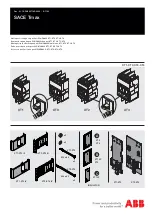
HT7
EN - 4
2. GENERAL DESCRIPTION
HT7 performs the following measurements:
DC voltage with 2-wire method
AC voltage with 2-wire method
AC voltage with 1-wire method (polarity detection)
Phase sequence indication
Continuity test with buzzer
Voltage measurement with low impedance input
The measure is displayed with indication of measurement unit both in numerical mode and
as bargraph. A white LED enabled by
key is also available to illuminate dark
environments.
3. PREPARATION FOR USE
3.1. INITIAL
This instrument was checked both mechanically and electrically prior to shipment. All
possible cares and precautions were taken to let you receive the instrument under perfect
conditions. Notwithstanding we suggest you to check it rapidly (any damage may have
occurred during transport).
Make sure that all standard accessories mentioned in § 6.3 are included.
Should you have to return back the instrument for any reason please follow the
instructions mentioned in § 7.
3.2. SUPPLY VOLTAGE
The instrument is powered by 2x1.5V alkaline batteries type AAA LR03. When batteries
are low, a low battery indication “
”
is displayed. To replace batteries follow the
instructions of § 5.2
3.3. CALIBRATION
The instrument complies with the technical specifications contained in this manual.
Considering its extremely friendly use, the instrument does not need any calibration.
3.4. STORAGE
After a period of storage under extreme environmental conditions exceeding the limits
mentioned in § 6.2.1, let the instrument restore normal measuring conditions before use.































